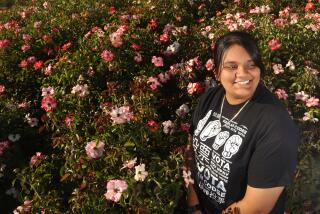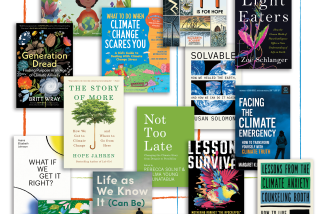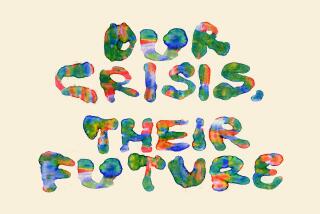Alan Weisman’s ‘Countdown’ points to Earth’s population explosion
In “The World Without Us,” Alan Weisman took readers for a romp through the misty primeval forest in Poland and splashed into gin-clear waters to gaze upon one the most remote and intact coral reefs in the Pacific Ocean. Besides highlighting a few of the world’s last remaining pristine places, the bestseller engaged in a thought experiment: If human beings were suddenly wiped off the face of Earth, how fast would nature overgrow cities with vegetation, reclaim the land, and demonstrate its remarkable resilience? For nature lovers, this fanciful future offered hope and irresistible images of Earth returning to a wild and happy place.
Now, six years later, Weisman has produced a sequel of sorts that adds humans back into the equation. And the place doesn’t look so happy.
In “Countdown: Our Last, Best Hope for a Future on Earth?,” Weisman explains that population is going in the wrong direction — by adding 1 million more people to the planet every 41/2 days — if we want to achieve some semblance of ecological sustainability. It’s not just this century’s projected growth to 11 billion that troubles him. Weisman is concerned about how the 7 billion of us already here are straining natural limits, from the buildup of heat-trapping gases in the atmosphere to the decline of available fresh water.
“Our numbers have reached a point where we’ve essentially redefined the concept of original sin,” Weisman writes. “From the instant we’re born, even the humblest among us compounds the world’s mounting problems by needing food, firewood, and a roof, for starters. Literally and figuratively, we’re all exhaling CO2 and pushing other species over the edge.”
The theme of the book focuses mostly on the ecological question, how many people can Earth support without capsizing? It’s not a new pursuit, of course. Scholars dating to Tertullian, in 2nd century Carthage, have written about a teeming population being “burdensome” to the world.
Weisman sets out to define an “optimum population” for a sustainable Earth, one that balances the overall human numbers with how much each person consumes. As far as per capita consumption is concerned, he proposes a European lifestyle as something that would be widely acceptable but not something as energy-intensive as living in the United States or as difficult as living in much of Africa and Asia.
He doesn’t specify an optimum target population, although he sketches some 20-year-old calculations by Stanford biologist Paul Ehrlich and colleagues that set the number at 2 billion or so. Instead, Weisman argues that we should get on a path of reducing our numbers or suffer the fate of the profusion of deer on Arizona’s Kaibab Plateau north of the Grand Canyon that starved to death in the 1920s.
“Like Kaibab deer, every species in the history of biology that outgrows its resource base suffers a population crash — a crash sometimes fatal to the entire species,” Weisman writes. “…Inevitably –- and, we must hope, humanely and nonviolently — that means gradually bringing our numbers down. The alternative is letting nature –- the new nature we’ve inadvertently created in our own image –- do that for us.” Such discussion is certain to raise protests, from the right as another false alarm in the tradition of Thomas Robert Malthus and from the left for focusing on the fast-growing ranks of the poor in the global South rather than reducing consumption in the rich North.
A serious environmental journalist, Weisman carefully backs up his assertions. He did a massive literature review, interviewed scores of experts and by his own account traveled to 20 countries. He goes to China to take a critical look at the totalitarian regime’s one-child policy and to Iran to praise an enlightened program launched by Ayatollah Khomeini that brought a huge voluntary drop in birthrates by educating women and providing free access to modern contraception.
Weisman takes on the Vatican’s stance on contraception, spars with Islamic clerics over confusing messages, and criticizes the pro-growth mantra of economists who ignore limits on natural resources and see a growing population as a wellspring of new customers and cheap labor.
Aside from a trip to Japan to show how prosperity can be found in a nation with shrinking population, his world tour illustrates the dismal consequences of rapid growth. He visits a slum in Mumbai. He hangs out with a gravedigger in Pakistan, the cleanup man dealing with a country bursting with population and explosive tensions. He interviews a white-goateed village chief in the West African nation of Niger, who boasts of 17 surviving children and multiple wives — his last taken “when she was twelve, when she was fresh.”
It’s admirable that Weisman, whose previous uplifting book sold more than a million copies in 30 languages, would tackle a subject that’s such a downer. Although written for the general reader, the 431 pages that mix travelogue with interviews of experts and assemblage of facts to support his analysis can be a tough slog at times — without the payoff of a bright future in a world without us.
He doesn’t fall into the seductive trap of contrarian authors who pronounce that the world’s rapid population growth will suddenly, magically correct itself or embrace blind faith that human ingenuity will triumph over adversity. Instead, he listens to the experts, such as the leaders of the world’s two preeminent agricultural research stations in Mexico and the Philippines, independently telling him that they don’t know how we can possibly produce enough food in the future to keep pace with our growing numbers.
In doing so, Weisman reminds us that when the experts are worried, we should pay attention.
Weiss, a former Los Angeles Times staff writer, is writing a book on population, health and the environment. A grant from the Pulitzer Center on Crisis Reporting supported this project.
Countdown
Our Last, Best Hope for a Future on Earth?
Alan Weisman
Little, Brown: 528 pp., $28
More to Read
Sign up for our Book Club newsletter
Get the latest news, events and more from the Los Angeles Times Book Club, and help us get L.A. reading and talking.
You may occasionally receive promotional content from the Los Angeles Times.








